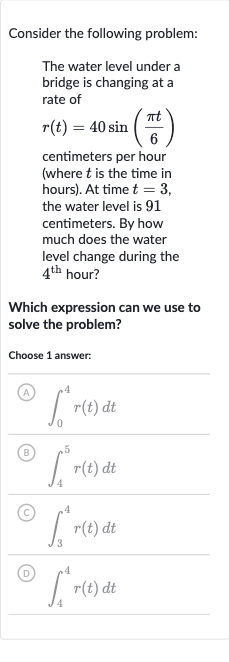AI tutor
Welcome to Bytelearn!
Let’s check out your problem:

Consider the following problem:The water level under a bridge is changing at a rate of centimeters per hour (where is the time in hours). At time , the water level is centimeters. By how much does the water level change during the hour?Which expression can we use to solve the problem?Choose answer:(A) (B) (C) (D)
Full solution
Q. Consider the following problem:The water level under a bridge is changing at a rate of centimeters per hour (where is the time in hours). At time , the water level is centimeters. By how much does the water level change during the hour?Which expression can we use to solve the problem?Choose answer:(A) (B) (C) (D)
- Define Time Interval: To find the change in water level during the hour, we need to evaluate the rate of change function from the start to the end of the hour. The hour starts at and ends at .
- Use Integral Expression: The correct expression to use for this problem is the integral of from to , which represents the total change in water level during the hour. This corresponds to option (C) .
- Calculate Integral: Now we will calculate the integral of from to .
- Apply Antiderivative Rule: To integrate, we use the antiderivative of , which is , where is a constant. In this case, . | from to
- Simplify Constant Factor: Simplify the constant factor in front of the integral. Now we have: | from to
- Evaluate Antiderivative: Evaluate the antiderivative at the upper and lower limits of the integral.
- Calculate Cosine Values: Calculate the cosine values. (since is in the second quadrant where cosine is negative) (since is the cosine of degrees, which is )
- Substitute Values: Substitute the cosine values into the expression.
- Simplify Expression: Simplify the expression to find the change in water level during the hour. centimeters
More problems from Evaluate definite integrals using the power rule
QuestionGet tutor help
QuestionGet tutor help
